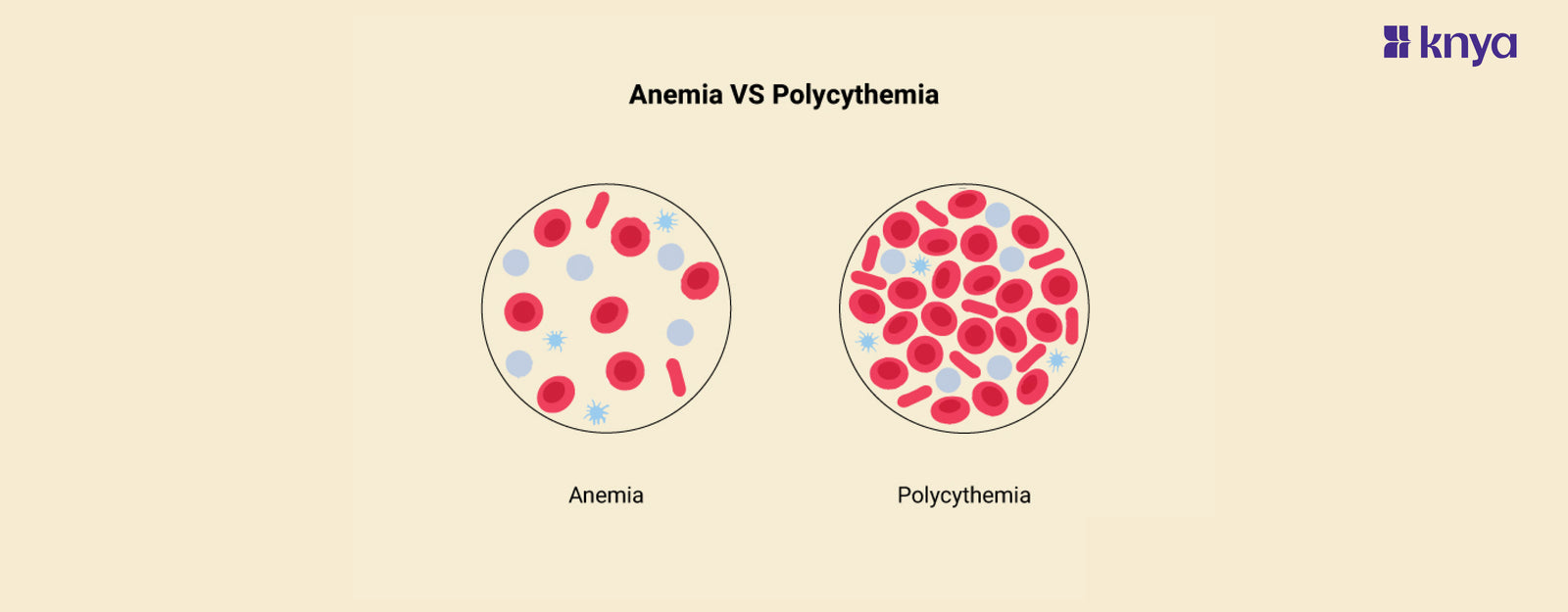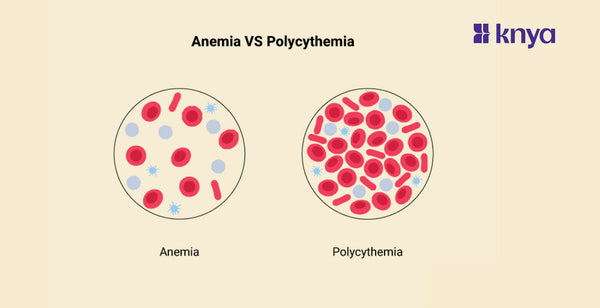Difference Between Anemia and Polycythemia: Anemia and Polycythemia are blood diseases distinguished by opposite deviations from normal red blood cell (RBC) counts. Anemia is defined as a lack of red blood cells or hemoglobin, which results in reduced oxygen supply to tissues and frequently causes symptoms such as weariness, weakness, and shortness of breath. Causes include blood loss, reduced RBC generation, and accelerated RBC destruction. Treatment often focuses on the underlying cause, attempting to restore RBC levels and ease symptoms. In contrast, Polycythemia is characterized by an overabundance of RBCs, which increases blood viscosity and increases the risk of clotting. Primary Polycythemia results from bone marrow abnormalities, but secondary variants might be caused by prolonged hypoxia or certain tumors.
Anemia
- Anemia is a blood condition characterized by a lack of red blood cells or hemoglobin, which reduces oxygen-carrying capacity.
- Anemia can be caused by blood loss, insufficient red blood cell synthesis (as a result of nutritional deficits or bone marrow abnormalities), or accelerated red blood cell breakdown.
- Anemia symptoms can include weariness, weakness, pale skin, shortness of breath, dizziness, and a rapid heartbeat.
- Blood tests are commonly used to diagnose hemoglobin levels, red blood cell count, and other characteristics.
Polycythemia
- Polycythemia is a blood condition characterized by an excess of red blood cells, which causes increased blood viscosity and the risk of blood clots.
- Primary Polycythemia, also known as polycythemia vera, is caused by bone marrow abnormalities that result in an overproduction of red blood cells.
- Secondary Polycythemia can develop in reaction to prolonged hypoxia or tumours that produce an excess of erythropoietin, the hormone that increases red blood cell synthesis.
- Polycythemia can include headaches, dizziness, blurred vision, itching (especially after a warm bath or shower), and reddish skin, particularly on the face.
Difference Between Anemia and Polycythemia
Anemia is a lack of red blood cells or hemoglobin, which causes symptoms such as weariness, whereas Polycythemia is an overabundance of red blood cells, which increases blood viscosity and may lead to clotting problems. Anemia is typically treated with iron supplementation or blood transfusions, whereas Polycythemia may require therapeutic phlebotomy or medicines to reduce red blood cell count. The table below provides differences between Anemia and Polycythemia.
|
Characteristic |
Anemia |
Polycythemia |
|
Definition |
Deficiency of red blood cells or hemoglobin, resulting in reduced oxygen-carrying capacity. |
Excess of red blood cells, leading to increased blood viscosity. |
|
Causes |
Blood loss, inadequate RBC production, increased RBC destruction. |
Primary (polycythemia vera) or secondary (e.g., hypoxia, tumors) causes excessive RBC production. |
|
Symptoms |
Fatigue, weakness, pale skin, shortness of breath, dizziness, rapid heartbeat. |
Headaches, dizziness, blurred vision, itching, reddened skin, especially in the face. |
|
Diagnosis |
Blood tests measuring hemoglobin levels, RBC count, and other parameters. |
Blood tests measuring RBC count, hemoglobin levels, and hematocrit. |
|
Treatment |
Iron supplementation, vitamin B12 injections, blood transfusions, or addressing the underlying cause. |
Therapeutic phlebotomy, medication to reduce RBC production, or addressing the underlying cause. |
Browse The Best Scrubs Collection!
What is Anemia?
Anemia is a medical condition characterized by a lack of red blood cells or a decrease in the amount of hemoglobin in the blood, resulting in reduced oxygen-carrying capacity and frequently leading to symptoms such as fatigue, weakness, pale skin, shortness of breath, dizziness, and rapid heartbeat.
Features of Anemia
- Fatigue: Feeling weary or weak, even after getting enough rest, is a frequent sign of Anemia caused by inadequate oxygen delivery to tissues.
- Pale Skin: Because of decreased blood flow and oxygenation, Anaemia can cause the skin to seem pale or washed out, particularly on the face, lips, and nail beds.
- Shortness of Breath: Reduced oxygen-carrying capacity in the blood can cause shortness of breath, especially during physical exercise or activity.
- Weakness: Anemia can result in generalized weakness or muscle exhaustion, making daily duties more difficult.
- Dizziness: A decrease in oxygen delivery to the brain can cause symptoms of lightheadedness or dizziness, particularly when standing up suddenly.
Causes of Anemia
- Iron Deficiency: Iron Deficiency is the most prevalent cause of anemia worldwide, and it is frequently caused by insufficient dietary intake, blood loss (such as gastrointestinal bleeding or heavy menstrual cycles), or disorders that impair iron absorption (e.g., celiac disease).
- Vitamin Deficiencies: Anaemia can be caused by a lack of vitamin B12 (pernicious anemia) or folate, which are both necessary for red blood cell synthesis.
- Chronic Diseases: Chronic renal disease, inflammatory illnesses (e.g. rheumatoid arthritis), and cancer can all impair the body's ability to manufacture red blood cells or hemoglobin.
- Bone Marrow Disorders: Aplastic anemia, myelodysplastic syndromes, and leukemia are examples of bone marrow disorders that can interfere with red blood cell synthesis.
- Hemolytic Anaemia: Conditions that cause an increase in red blood cell destruction, such as autoimmune disorders, hereditary conditions (e.g., sickle cell disease, thalassemia), or drug or toxin reactions.
- Chronic Blood Loss: Prolonged or repeated blood loss, whether due to gastrointestinal bleeding (ulcers, tumors) or monthly bleeding, can result in Anaemia over time.
Symptoms of Anemia
- Fatigue: Feeling weary or weak, even after enough rest, is a defining feature of Anaemia caused by inadequate oxygen delivery to tissues.
- Pale Skin: Anaemia can cause pale or washed-out skin, particularly on the face, lips, and nail beds, due to decreased blood flow and oxygenation.
- Shortness of Breath: Reduced oxygen-carrying capacity in the blood can cause shortness of breath, especially during physical exercise or activity.
- Weakness: Anaemia can induce generalized weakness, which makes daily duties more difficult.
- Dizziness: A decrease in oxygen delivery to the brain can cause symptoms of lightheadedness or dizziness, particularly when standing up suddenly.
- Rapid Heartbeat: The heart may beat faster than usual to compensate for low blood oxygen levels.
What is Polycythemia?
Polycythemia is a blood condition characterized by an overabundance of red blood cells in the bloodstream, which causes increased blood viscosity. Primary Polycythemia, also known as Polycythemia vera, is caused by abnormalities in the bone marrow that result in excessive red blood cell production, whereas Secondary Polycythemia is caused by situations such as chronic hypoxia or certain tumors.
Features of Polycythemia
- Increased Red Blood Cell Count: Polycythemia is defined by a rise in the number of red blood cells circulating in the bloodstream, resulting in higher-than-normal levels of red blood cells.
- Increased Haemoglobin Amounts: In addition to an enhanced red blood cell count, Polycythemia frequently leads in higher amounts of hemoglobin, the protein that transports oxygen in the blood.
- Increased Blood Volume: Excess red blood cells contribute to an overall increase in blood volume, which can cause higher blood pressure and put more strain on the cardiovascular system.
- Increased Blood Viscosity: When there are more red blood cells in the blood, the viscosity, or thickness, increases, which can hinder blood flow and circulation, potentially leading to issues like blood clots.
- Hyperviscosity: Symptoms of hyperviscosity syndrome include headaches, dizziness, blurred vision, weariness, itching (especially after a warm bath or shower), and reddish skin (particularly on the face).
- Risk: Individuals with Polycythemia are at a higher risk of developing blood clots (thrombosis), which can lead to catastrophic problems such as stroke or heart attack.
Causes of Polycythemia
Polycythemia is classified into two types: primary (sometimes called polycythemia vera) and secondary.
- Primary Polycythemia: Primary Polycythemia (Polycythemia Vera) is caused by a genetic abnormality in bone marrow cells, which produce red blood cells. This mutation causes an overproduction of red blood cells. The specific source of this mutation is unknown, however it is thought to be a combination of genetic and environmental causes.
- Secondary Polycythemia: Secondary polycythemia develops when an underlying illness or external event causes the body to create extra red blood cells. Some common causes are:
- Chronic hypoxia (low oxygen levels) can be caused by illnesses such as chronic obstructive lung disease (COPD), sleep apnea, or living at altitude.
- Kidney disorders, especially when there is insufficient oxygen transport to the tissues.
- Smoking can increase carbon monoxide levels in the blood, lowering oxygen levels and increasing the formation of red blood cells.
- Congenital heart disease or other heart disorders resulting in persistent hypoxia.
Symptoms of Polycythemia
- Fatigue: Excessive tiredness or weakness.
- Headaches: Chronic or severe headaches that are frequently described as throbbing or pounding.
- Dizziness or Lightheadedness: Feeling faint or dizzy, particularly after getting up fast.
- Shortness of breath: Difficulty breathing, particularly while exercising or laying flat.
- Itching: Especially after a bath or exposure to warm water.
- Blurred Vision or Visual Disturbances: Examples include seeing dots or flashes of light.
- Joint Pain or Discomfort: Specifically in the hands, foot, or limbs.
- Reddened or Flushed Complexion: Especially on the face and ears.
- Splenomegaly: An enlarged spleen can produce discomfort or fullness in the upper left abdomen.
- Excessive Sweating: Particularly at night.
Shop Best Lab Coats From Here!
Similarities Between Anemia and Polycythemia
- Hematological Illnesses: Anemia and Polycythemia are also considered hematological illnesses, which means they involve blood abnormalities.
- Impact on Oxygen Deliver: Both disorders impair the ability of the blood to deliver oxygen to tissues. Anemia is characterized by a lower number of RBCs, which reduces oxygen-carrying ability. Polycythemia is characterized by an increased quantity of RBCs, which can result in increased blood viscosity and perhaps impaired oxygen delivery to tissues.
- Fatigue Symptoms: Both illnesses share the common symptom of fatigue. Fatigue in Anemia is caused by a reduction in oxygen delivery to tissues, but fatigue in Polycythemia might be caused by increased blood viscosity and accompanying problems.
- Potential Cardiovascular Complications: Both Anemia and Polycythemia can cause cardiovascular issues. Anemia can cause symptoms including palpitations, shortness of breath, and chest pain because the heart has to work harder to compensate for lower oxygen levels. Polycythemia, on the other hand, raises the risk of thrombosis (blood clot formation), which can result in stroke or heart attack.
- Diagnostic Testing: Both disorders are frequently diagnosed using blood tests to determine RBC counts, hemoglobin levels, and hematocrit (the percentage of blood volume occupied by RBCs). Additional testing may be required to discover the underlying cause of Anemia or Polycythemia.
To summarize, Anemia and polycythemia are two hematological diseases that provide unique diagnostic, therapeutic, and management problems. Anemia is characterized by a lack of red blood cells or hemoglobin, which causes weariness and weakness owing to inadequate oxygen delivery to tissues, whereas polycythemia is characterized by an overabundance of red blood cells, which can lead to complications such as increased blood viscosity and clotting.
Order the Best Jogger Scrub From Here!
| Check out More Articles | |
| Difference Between Tendon and Ligament | |
| Difference Between Seizure and Epilepsy | |
| Difference Between Hypothyroidism and Hyperthyroidism | |















